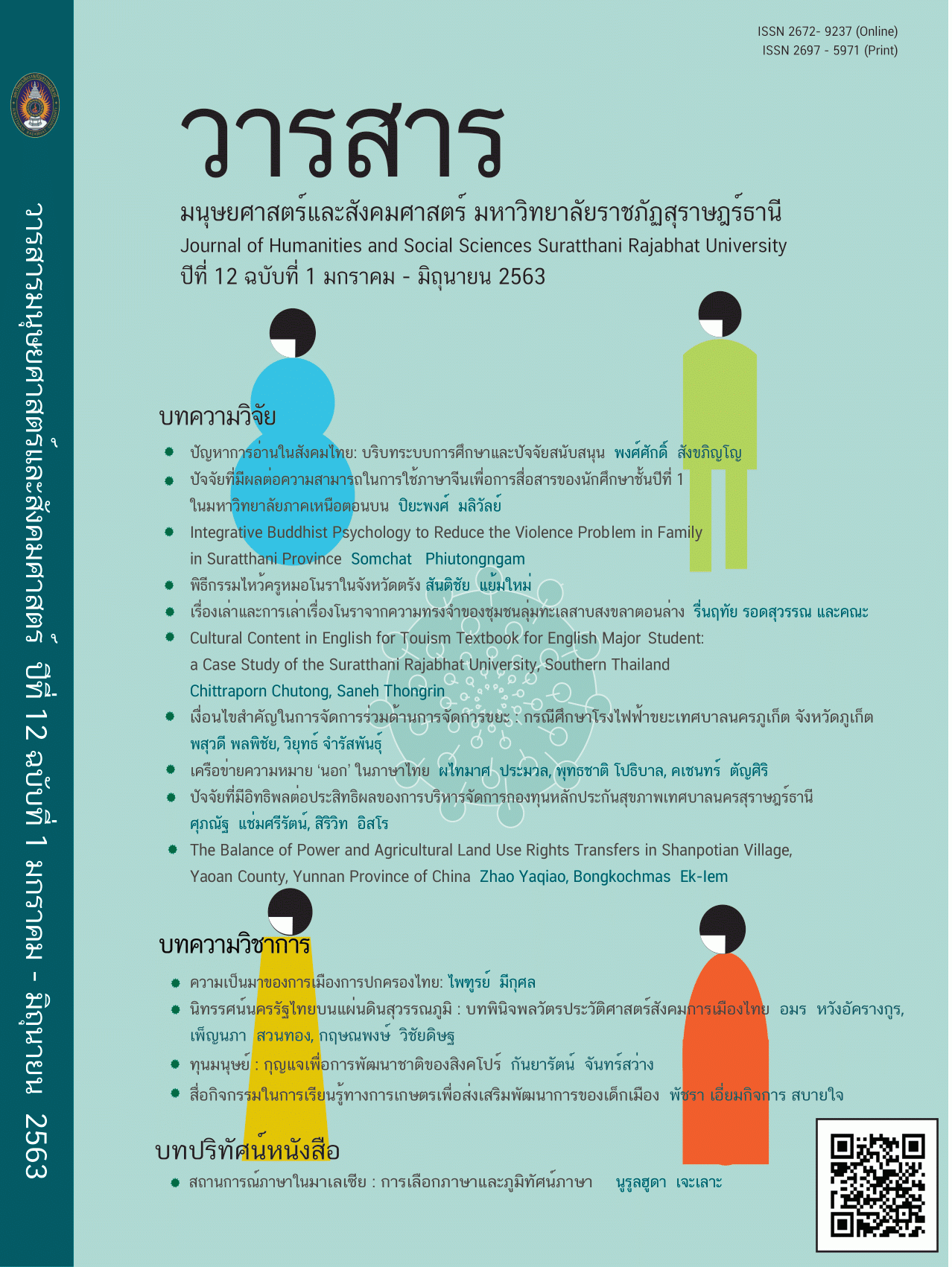Causal Factors Affecting to the Chinese Language for Communication Competency of the 1st Year University Students in Northern Thailand
Main Article Content
Abstract
This research is aimed (1) to investigate the factors that affect the Chinese language for communication competency of the 1st year university students in upper-northern Thailand, (2) to study strengths and weaknesses that affect language coThis research is aimed to (1) investigate the factors that affect the Chinese language competency for communication, (2) to study strengths and weaknesses that affect the language competency and (3) to seek for the ways and suggestions to enhance communication. Students selected for this study were first-year university students majoring in Chinese in a second semester, academic year 2018 in 4 universities in 3 provinces in theupper-northern. The study employed purposive sampling and the Yamane formula, Krejcie and Morgan formula to determine the sample number,
resulting in the number of 228 samples. According to the t-table calculation, it was found the main factor affecting the language competency was priorknowledge of Chinese before entering university which resulted 2.359 in the T value, higher than 1.895 at 0.05 of the level of significance. Moreover, the weaknesses of studying Chinese prior to entering university were different textbooks used by different schools, inconsistent communication skill
practice, incapability of communicating in various situations, and plagiarizinginformation in new media. Racial factor which was found 1.875 of thet-value, lower than 1.895, with the level of significance of 0.05, does not correlate with the Chinese competency for communication. Therefore, to provide continuing language learning for students, school should carefully design the curriculum or Chinese language course aligning with the basic education core curriculum A.D. 2008 as well as equip students withanalytical skills for New Media in tertiary education level.mpetency and (3) to seek for the ways and suggestions to enhance communication. Students selected for this study were the group of 1st year university students majoring in Chinese in the second semester academic year 2018 in 4 universities in the 3 provinces in the upper-northern Thailand. The purposive sampling was used in the selection of case studies, and the Yamane formula to determine the case study group. that resulted in the group of 228 cases. According to the t-table calculation, it was found the main factor that affect the language competency is prior knowledge of Chinese before entering university which resulted 2.359 in the T value, which is higher than 1.895 at 0.05 of the level of significance. Also. However, prior high school knowledge from different backgrounds created an inconsistent learning ability in university. New medias can also lead students to deviant learning behavior such as mismanagement of time and plagiarism. Racial factor which was found 1.875 of the t-value, which is lower than 1.895, with the level of significance of 0.05, does not affect the language competency at all. In order to improve Chinese language teaching, curriculum must be revisited and revised. New media is powerful, but it needs improvement to assist language learning.
Article Details

This work is licensed under a Creative Commons Attribution-NonCommercial-NoDerivatives 4.0 International License.
All published manuscripts have been verified by peer-peer professors in the fields of humanities and social sciences. Reprinting of the article must be authorized by the editorial staff.
References
กระทรวงศึกษาธิการ. (2551). มาตรฐานสาระการเรียนรู้ภาษาจีนระดับการศึกษา
ขั้นพื้นฐาน พุทธศักราช 2551.
กาญจนา แก้วเทพ, และนิคม ชัยชุมพล. (2555). คู่มือสื่อใหม่ศึกษา. กรุงเทพฯ: สำนักงาน
กองทุนสนับสนุนการวิจัย.
จี. วิลเลี่ยม สกินเนอร์ เขียน ชาญวิทย์ เกษตรศิริ และคณะแปลเรียบเรียง. (2529).
สังคมจีนในไทย. กรุงเทพฯ: มูลนิธิโครงการตำราสังคมศาสตร์และมนุษยศาสตร์.
งานทะเบียนนิสิต มหาวิทยาลัยพะเยา. (2561). เอกสาร/รายงานสถิติ. [ออนไลน์]. เข้าถึง
ได้จาก http://reg.up.ac.th/. [2561, ตุลาคม].
บุญชม ศรีสะอาด. (2556). การวิจัยเบื้องต้น. พิมพ์ครั้งที่ 9. กรุงเทพ: สุวีริยาสาส์น.
ศุภชัย แจ้งใจ. (2552). ปัจจัยที่ส่งผลต่อการเรียนภาษาจีนของผู้เรียน สาขาวิเทศธุรกิจจีน
และสาขาจีนศึกษา คณะวิเทศศึกษา มหาวิทยาลัยสงขลานครินทร์ วิทยาเขตภูเก็ต.
สำนักส่งเสริมวิชาการและงานทะเบียน มหาวิทยาลัยราชภัฏเชียงราย . (2560). รายงาน
จำนวนหมู่เรียน. [ออนไลน์]. เข้าถึงได้จาก http://orasis.crru.ac.th/orasis_
mis/student#. [2561, ตุลาคม].
สำนักทะเบียนและประมวลผล มหาวิทยาลัยเชียงใหม่. (2561).รายงานสถิติจำนวน
นักศึกษา มหาวิทยาลัยเชียงใหม่. [ออนไลน์]. เข้าถึงได้จาก https://www.reg.
cmu.ac.th/misreg/misreport/major451.php?std_level=u&fac=01.
, ตุลาคม].
วรากร แซ่พุ่น ภากร นพฤทธิ์ วราลี รุ่งบานจิต วรทา รุ่งบานจิต วรานาถ แซ่เซ่น และ
ชุติมา คำแก้ว. (2560). วารสารมหาวิทยาลัยราชภัฏยะลา. ปีที่ 12 ฉบับพิเศษ
กุมภาพันธ์ 2560.
เหยิน จิ่งเหวิน. (2546). จุ๊กจิ๊กจอจีน เล่ม 1. กรุงเทพฯ: สุดสัปดาห์.
scholarship ทุนเรียนต่อต่างประเทศ. (2016, February 19). ตามสถิติแล้ว ประเทศไทย
มีชาวจีนผู้อพยพเข้ามาอาศัยเป็นอันดับ 1 ของโลก !!?. [ออนไลน์]. เข้าถึงได้จาก
http:// www.scholarship.in.th/ตามสถิติแล้ว-ประเทศไทย. [2561,
ตุลาคม].
Clark, J.L.D. (1972). Foreign Language Testing: Theory and Practice.
Philadephia: Centre of Curriculum Development.
Carroll, Brenda Joseph. (1982). Testing Communication Performance.
London.
Division of Registrar Mae Fah Luang University. (2018, January). Number of
Students, Second Semester 2017 (by Level and ID). [Online].
Retrieved form http://reg.mfu.ac.th/regpage/studentstat/student
stat25602.htm. [2018, October].
Likert, Rensis. (1932). A Technique for the Measurement of Attitudes.
Archives of Psychology.
Oller, J. W. (1979). English Testing at School. London : Longman Group
Lte. p.320 – 323.
Peng Liting. (2557). วารสารกระแสวัฒนธรรม. ปีที่ 15 ฉบับที่ 28 กรกฎาคม – ธันวาคม
กรุงเทพฯ: มหาวิทยาลัยสยาม.


